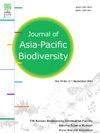日本伊豆群岛富岛条纹鹱(Calonectris leucomelas)洞穴内无脊椎动物的多样性
IF 0.7
Q4 BIODIVERSITY CONSERVATION
引用次数: 0
摘要
鸟巢形成了一个独特的环境,支持着一个多样化的无脊椎动物群落,这在生物多样性研究中经常被忽视。本研究分析了日本伊豆群岛丰岛Calonectris leucomelas巢穴中的无脊椎动物群落,共确认了292个个体。昆虫为优势纲(49%),其次为蜘蛛纲(28.1%)、甲壳纲(18.8%)、腹足纲(2.1%)、双足纲(1.7%)和寡毛纲(0.3%)。在昆虫纲中,鞘翅目的丰度最高(97.2%),其中niponensis占82.5%。在蛛形纲中鉴定出了散污亚目。甲壳类以等足目(85.5%)和圆球虫(80%)为主。腹足目包括柱头足目和棘足目的成员,而双足目包括Polydesmida目和一个未确定的目。寡毛纲以单一种为代表。40.4%为“角蛋白摄食者”,包括尼泊尼绒螯蟹成虫和Trox幼虫。“食腐动物”类占24%,“吸血”类在蛛形纲中占28.1%,“其他”类占1.7%。此外,5.8%的人被归类为“不确定”。这一全面的研究揭示了白桦冠蚁巢与各种无脊椎动物群落之间的复杂关系,这些关系影响着巢的利用模式,并可能影响雏鸟的生存。本文章由计算机程序翻译,如有差异,请以英文原文为准。
Diversity of invertebrates within the burrows of the streaked shearwater (Calonectris leucomelas) on Toshima Island, Izu Islands, Japan
Bird nests form a unique environment that supports a diverse community of invertebrates, which is often overlooked in biodiversity studies. This study analyzed the invertebrate communities in the nests of Calonectris leucomelas on Toshima Island in the Izu Islands, Japan, confirming a total of 292 individuals. Insecta was the dominant class (49%), followed by Arachnida (28.1%), Crustacea (18.8%), Gastropoda (2.1%), Diplopoda (1.7%), and Oligochaeta (0.3%). Within the class Insecta, Coleoptera exhibited the highest abundance (97.2%), with Trox niponensis representing 82.5%. The suborder Metastigmata was identified within Arachnida. In Crustacea, Isopoda (85.5%) and Spherillo dorsalis (80%) were prevalent. Gastropoda included members of Stylommatophora and Architaenioglossa, whereas Diplopoda contained Polydesmida and an unidentified order. Oligochaeta was represented by a single species. Food habit classification revealed 40.4% as “Keratin feeders,” including T. niponensis adults and Trox larvae. “Detritivores” constituted 24%, “Blood-sucking” species in Arachnida accounted for 28.1%, and the “Other” category (1.7%) included various species. Additionally, 5.8% were classified as “Uncertain.” This comprehensive examination provides insights into the intricate relationships between C. leucomelas nests and the diverse invertebrate communities that influence nest utilization patterns and potentially impact nestling survival.
求助全文
通过发布文献求助,成功后即可免费获取论文全文。
去求助
来源期刊

Journal of Asia-Pacific Biodiversity
Agricultural and Biological Sciences-Insect Science
CiteScore
1.70
自引率
12.50%
发文量
94
审稿时长
27 days
期刊介绍:
The Journal of Asia-Pacific Biodiversity (previous title was Journal of Korean Nature) is an official journal of National Science Museum of Korea (NSMK) and Korea National Arboretum (KNA). The scope of journal is wide and multidisciplinary that publishes original research papers, review articles, as well as conceptual, technical and methodological papers on all aspects of biological diversity-its description, analysis and conservation, and its application by humankind. This wide and multidisciplinary journal aims to provide both scientists and practitioners in conservation theory, policy and management with comprehensive and applicable information. However, papers should not be submitted that deal with microorganisms, except in invited paper. Articles that are focused on the social and economical aspects of biodiversity will be normally not accepted.
 求助内容:
求助内容: 应助结果提醒方式:
应助结果提醒方式:


